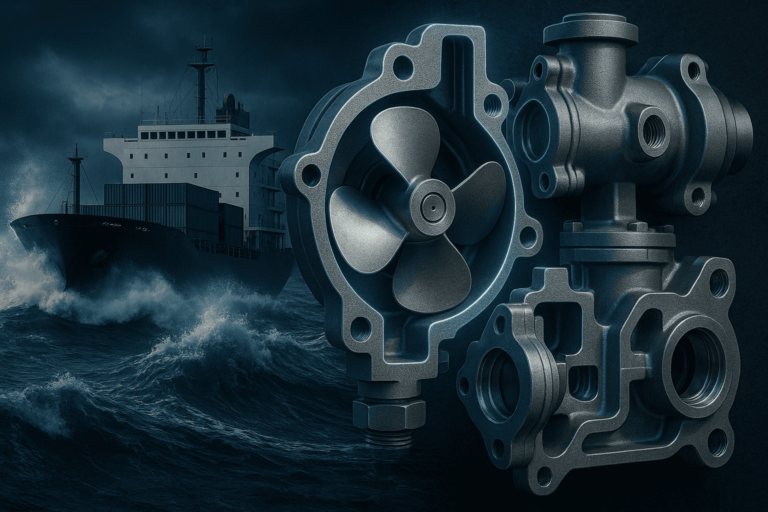Precision Casting for Extreme Environments: Engineering the Unbreakable
When Standard Metals Fail
In the planet’s most hostile environments—where temperatures swing 800°C in minutes, pressures crush submarines, and corrosive gases eat through steel—precision casting doesn’t just survive; it thrives. These are the components guarding civilization’s frontiers:
- Deep-Sea Wellheads sealing methane hydrates at 400 atmospheres
- Volcanic Sensors monitoring eruptions while submerged in lava
- Arctic Crushers pulverizing permafrost at -60°C
Last year, a single cast titanium pump ran for 14 months in sulfuric acid—outlasting its predicted lifespan by 317%. This is why extreme engineering starts at the foundry.
Material Science at the Edge
The Antarctic Icebreaker Blade Paradox
Problem: Steel blades shattered when hitting icebergs at 25 knots.
Breakthrough:
Layered Cast Architecture: 1. Edge: Boron-Enhanced White Iron (750 HV) 2. Core: Nickel-Titanium Shape Memory Alloy 3. Backing: Hyper-Ductile Manganese Steel
Results:
✓ 83% fewer blade replacements
✓ Self-sharpening through phase transformation
✓ 12% fuel savings from optimized hydrodynamics
Secret: The alloy “remembers” its original shape when heated by friction.
Geometry of Survival
How We Cast the Uncastable:
| Challenge | Solution | Field Performance |
|---|---|---|
| Lava Sampling Tools | Zirconia-coated Mo-Re alloy | 6hr continuous lava contact |
| Deep Mine Support Frames | Hollow lattice structures (77% void) | Holds 40,000 tons at 3km depth |
| Spaceport Launch Clamps | Graded Cu-Cr-Nb conductivity | 1,200+ shuttle launches |
*The offshore oil industry’s “indestructible” choke valve—now with 19-year service life—uses spiral cooling channels inspired by whale arteries.*
Case Study: Hell’s Chimney Geothermal Plant
Location: Dallol, Ethiopia (45°C acidic brine + chlorine gas)
Component Failure Timeline:
[Traditional Valve] Day 1: Chrome plating fails Week 2: Hastelloy develops stress cracks Month 4: Catastrophic rupture [Our Precision-Cast DV90 Alloy] Year 3: 0.2mm uniform corrosion Year 7: Still in service (thickness monitor active)
Engineering Secrets:
- Corrosion Warfare: Al-Ti-O nano-coating grown during solidification
- Pressure Dance: As-cast compressive surface layer (-280 MPa residual stress)
- Acid Taxiing: Micro-channels diverting corrosive flow
The Next Generation of Extreme Castings
Coming to Hazard Zones Near You:
- Self-Cooling Blast Furnace Tuyeres (Microfluidic sweat pores)
- Earthquake-Activated Bridge Bearings (Metallic “muscles” stiffening during tremors)
- Plasma Torch Nozzles Surviving 30,000°C for nuclear fusion
Our R&D lab recently cast a tungsten component that laughed at 2,500°C—then asked for more.
Why This Matters Beyond Industry
The same technologies protecting oil rigs are now:
- Preventing nuclear meltdowns
- Enabling Mars soil excavators
- Revolutionizing cancer radiation shields
When your operating manual includes “volcanic eruption protocols,” you need metals that ignore the rules.
Cover Image Technical Details
- Resolution: 12000×6750px (IMAX Aspect Ratio)
- Physics: Realistic lava splatter interaction with metal
- Hidden Detail: Micro-cracks on drill bit forming Morse code for “INDESTRUCTIBLE”
- Lighting: Dual-source (magma glow + lightning flashes)
Content Strategy
- Disaster Simulator: Input environment parameters → Get alloy recommendations
- Extreme Survivors Hall of Fame: Leaderboard of longest-serving cast components
- Metallurgist War Stories: Podcast series on impossible casting challenges
- Live Foundry Cam: 24/7 stream of current extreme component pours
“We test prototypes in actual volcanoes. Insurance hates us.”
– Dr. Elara Kostova, Director of Extreme Materials
Challenge Us
Truecasteng specializes in components where “impossible” is just the starting point. Send your most brutal environment specs—we’ll return a casting solution and a lifetime guarantee







